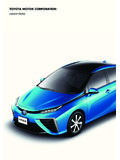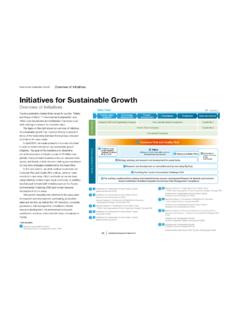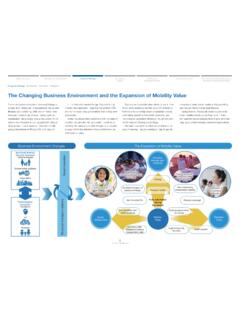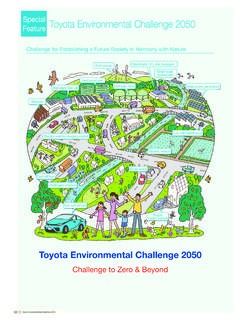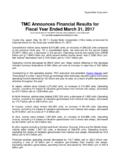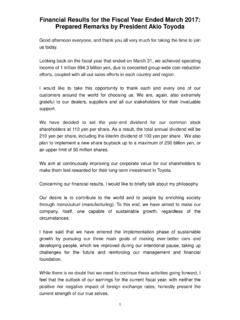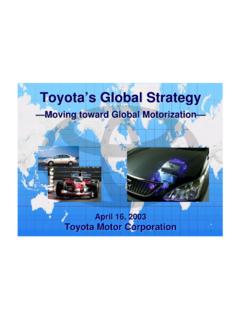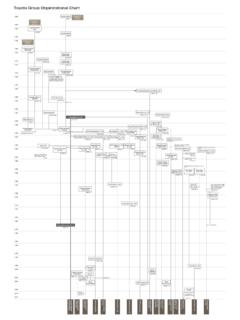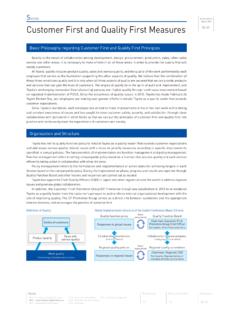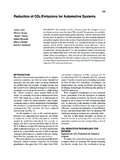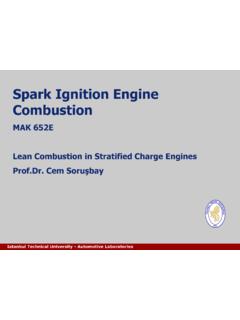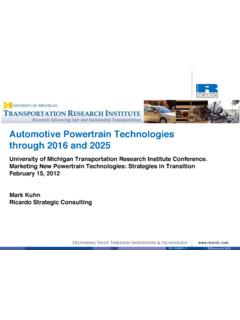Transcription of New Vehicle Zero CO2 Emissions Challenge
1 Challenge 1: New Vehicle Zero CO2 Emissions Challenge Annual greenhouse gas Emissions (1,000 Tg CO2 ) 140 120 100 80 60 40 20 0 20 2000 2020 2040 2060 2080 2100 Forecast international climate change Source: From the IPCC Working Group III 5th Assessment Report (2014) Full-scale initiatives to reduce CO2 Emissions Zero or less Baseline scenario (+ ~ C) ( ) Below 2 C scenario ( ) Regarding GHG Emissions , there is no time to lose Challenge 1: New Vehicle Zero CO2 Emissions Challenge 90 reduction 2010 2050 Average new Vehicle CO2 (TtW) 90% reduction of new Vehicle CO2 Emissions by 2050 compared to 2010 2020 2050 Engine HV PHV FCV EV 2010 Sales Volume Development of next generation vehicles Next generation vehicles to accelerate technological development to follow market expansion of HV New Vehicle Zero CO2 Challenge Cooperation with stakeholders Governments Customers Automotive companies Energy suppliers New Vehicle Zero CO2 Challenge in cooperation with stakeholders Energy diversity Renewable energy CO2-free hydrogen Energy saving Reduced use of fossil fuels CO2 reduction Energy saving Reduced use of fossil fuels CO2 reduction initiatives Engine HV PHV EV FCV Short-mid term to promote energy saving Powertrain with improved efficiency Aiming for further engine improvement in thermal Engine thermal efficiency ( )
2 Diesel 2050 2015 2010 2005 2000 1995 Hybrid Gasoline Improved thermal efficiency HV: Lineup Compact Medium Large/ Premium SUV Minivan Commercial HV lineups for all categories 9 8 7 6 5 4 3 2 1 0 Cumulative (million) 1997 1999 2001 2003 2005 2007 2009 2011 2013 2015 (January to July) 0 Per year (million) 1 M 3 M 5 M 8 million HV: Sales Sales (per year) Sales (cumulative) More than 8 million HVs in world wide cumulative sales in 2015 9 8 7 6 5 4 3 2 1 0 Cumulative (million) 0 Per year (million) 1997 1999 2001 2003 2005 2007 2009 2011 2013 2015 (January to July) 0 0 10 20 30 40 50 60 Cumulative (million t) (million t/year 4 6 8 10 12 2 58 million t CO2 reduction amount (per year) CO2 reduction amount (cumulative) 1 M 3 M 5 M 8 million Sales (per year) Sales (cumulative) 58 million tons of cumulative CO2 reduction compared to same class gasoline vehicles HV: Sales HV system cost Fuel efficiency (km/L) HV technology evolution 10-15 cycle Japanese test cycle JC08 cycle (Target:40) First-generation Prius Second-generation Prius Current Prius Next-generation Prius HV technology significantly evolved in fuel efficiency with reduced cost Next generation Prius is a compilation of world top fuel efficiency technologies Advanced fuel efficiency technology of nextgeneration Prius 3.)
3 Improved aerodynamics Aerodynamic coefficient (in Cd): efficiency/low fuel consumption engine 40% of maximum thermal efficiency 2ZR-FXE 2. Hybrid system Downsized/light weight, reduced loss Lithium ion battery Stator Rotor High rotation motor Battery Transaxle PCU Nickel metal hydride battery Transaxle PCU 1997 2000 2005 2010 2015 2020 2050 0 1 8 15 million Cumulative sales of HV 2020 target Cumulative 15 million HVs HV target cumulative 15 millions in 2020, to lead next generation vehicles Energy diversity Renewable energy CO2-free hydrogen Energy saving Reduced use of fossil fuels CO2 reduction Energy diversity Renewable energy CO2-free hydrogen CO2 reduction initiatives Engine HV PHV EV FCV Renewable energy, CO2 free hydrogen for further reduction PHV EV FCV HV Application of hybrid technology HV technology is a core technology included in next generation vehicles Fuel diversity and uses Short-distance commuter Vehicle Fuel Electricity Gasoline, diesel, biofuels, CNG, synthetic fuels, etc.
4 Hydrogen Delivery Vehicle EV HV PHV FCV BUS) FCV Vehicle size Passenger car Route bus Personal mobility EV HV/PHV FCV Home delivery truck Full-size truck Travel distance EV: Short-distance, HV & PHV: Wide-use, FCV: Medium-to-long distance Development of next generation batteries Output density (W/L) 10000 4000 2000 0 0 Energy density (Wh/L) 8000 200 400 600 800 1000 10000 6000 High capacity Li-ion battery Target Innovative battery (Metal air battery, etc) All solid battery Target Current (Research) Sakichi battery Develop next generation battery as a key for electrified vehicles to expand Development of next generation power semiconductor Power module Power control unit (PCU) Power semiconductor Diode Transistor Silicone (current) SiC future 10% increase in fuel efficiency (Target) Downsized PCU (1/5 in volume (target) Aim 10% increase in fuel efficiency, 1/5 downsized in volume Use of hydrogen: FCV Volume production FCV MIRAI Japan launch in 2014 Europe, in September, US in October, 2015 Advantages of FCV Energy diversity Zero Emissions Usage Zero tailpipe CO2 Hydrogen sourced from a wide variety of primary energy Electric motor enables smooth, quiet driving Excellent acceleration at start to low/mid speed Fun to drive Range (gasoline equivalent Refueling (about 3 minutes) High capacity Power supply (emergency use) Development of MIRAI Reduced number of cells in FC stack Common use of hybrid units FC boost converter FC stack Innovative flow channel structure and Electrodes of cells for higher output Output/volume; Humidifier less Internal circulation High pressure hydrogen tank The light weight structure of carbon fiber reinforced plastic enabled Storage.)
5 Wt%* world top level world top level *Hydrogen mass/Tank mass FC main components developed in-house to achieve world leading performance Power control unit Motor Battery HV technology FC technology FC stack High-pressure hydrogen tanks Cost reduction of FCV Limited introduction Start penetration Popularization FCHV-adv (2008) 1/20 or less (2014) Further Cost reduction FC system cost Apply HV technology to accelerate cost reduction FCV market penetration initiatives About 5,680 FCV related Toyota patent Item Number of patents to be free Free use period FC stack High-pressure hydrogen tanks FC system control Hydrogen station Approx. 1,970 Approx. 290 Approx. 3,350 Approx. 70 Until the end of 2020 No expiration Announcement at CES on January 6 by TMS SVP Bob Carter Toyota share all patents for free to accelerate the spread of FCV FCV market penetration initiatives 3 automakers; Toyota, Nissan, Honda started cooperative promotion of supporting hydrogen station operation until around 2020 1) Support operational cost 2) Refueling network Customer services/Convenience Communication for understanding of FCV and hydrogen Support to accelerate preparation of hydrogen stations Various approaches of Toyota group TOYOTA FCV Toyota Auto Loom folk lift Aisin Seiki Household fuel cell system HINO FC bus Not only FCV but also Toyota group activities to promote hydrogen use FCV market penetration initiatives FCV sales volume Global : More than 30,000/year around 2020 and later Japan : Approx.
6 1,000/month around 2020 1X,000/year @2020 and later FC bus introduction to start in FY 2016 for Tokyo, etc 100 or more by 2020 for Tokyo Olympics/Paralympics 2020 2050 Engine HV PHV FCV EV 2010 Sales Volume PHV FCV EV Future development of next generation vehicles Accelerate next generation Vehicle development toward 90% CO2 reduction CO2
